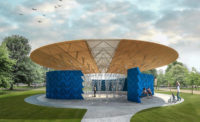Sheltered by a curved canopy that spreads up and outward from a trunk of delicate steel columns, the 2017 Serpentine Gallery Pavilion is modeled on the area beneath trees—spaces, according to its architect, Diébédo Francis Kéré, “where people can choose to gather, or enter, in different ways.”
The pavilion responds to the gallery’s sylvan setting in London’s Kensington Gardens, but was inspired by the shaded gathering places of the desert village in Burkina Faso where Kéré grew up, and where his Berlin-based studio continues to work extensively.
With its heavy, rugged walls detached from an oversailing, skeletally-framed roof, the structure recalls the African community buildings for which Kéré first attracted attention while a student of architecture. And though realized in a very different context, it successfully translates his concerns for “a sense of openness”—both social and spatial‑and experimental construction techniques employed for both economy and effect.
“Experiment” is the watchword of the pavilion program, which was launched in 2000 to exhibit built works by international architects who had not yet completed a building in England. Its brief asks only that a temporary structure should cover at least 3,230 square feet, accommodate a café, and be able to host diverse events. Since 2013 the focus has shifted from established figures (Frank Gehry, Zaha Hadid, and SANAA, to name a few) to emerging architects, and Kéré’s selection signals an increased emphasis on architecture as a catalyst for social interaction, according to the gallery’s artistic director, Hans Ulrich Obrist. The selectors were particularly struck by Kéré’s “passion for storytelling and desire to convene,” says Serpentine CEO, Yana Peel.
All of the building’s components are drawn into Kéré’s narratives, most notably the roof, which acts both to protect visitors from the elements and to register and celebrate changes in light and weather. Formed as a shallow inverted cone, it is supported by 28 slender trusses that spring from 14 steel lattice columns grouped in a tight ring to define an oculus in the center of the pavilion. Rainwater is funneled through this aperture to form a cascade in the heart of the structure, where it lands on porous gravel and drains to subterranean storage tanks.
“In London you are spoiled,” says Kéré with an apologetic laugh. “You have everything and you don’t even know it. Water is precious and I wanted to recognize that—not just symbolically, but in a way that is real.” Water stored in the nearly 2,400-gallon tank will be used to irrigate the park.
Below the translucent polycarbonate covering, a brise soleil of thin wooden slats is arranged in rings of leaf-life triangular panels, angled to cast shadows across the surface and dapple animated patches of sunlight across the concrete floor and the four freestanding walls.
These deep-blue snaking screens are formed from 520 triangular blocks, prefabricated from lengths of solid 3” by 8” lumber. Angled cuts in the wood create faceted profiles on the outer faces, lending a pronounced texture and varied sheen, so that the play of light and shadow enlivens the dark mass of the walls. The choice of color alludes to indigo-dyed clothes worn for courting calls in Gando, says Kéré. “If you come to a new place, you want to show your best side. I wanted to present myself—and my architecture—in blue.” The textile allusion is developed further in gaps between the blocks formed by their stepped edges, which produce chevron patterns in the facades like woven cloth.
Light and breezes pass through these openings, and through the larger gap between the walls and the roof, so that visitors within the pavilion are always in touch with climatic conditions. “The walls are open,” Kéré says, “It’s breathing.” At night, the glow of electric light seeping through these gaps will beckon to passersby across the darkened park as “a beacon of light,” architect says; “a symbol of storytelling and togetherness.”








